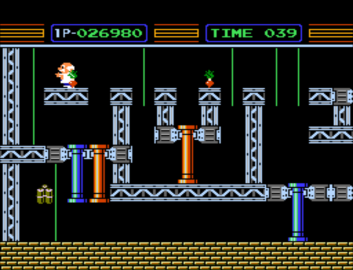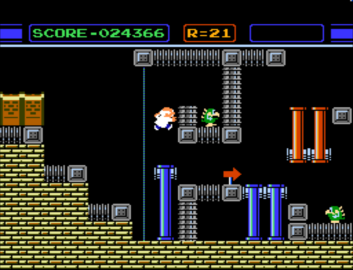
On Romhack Thursdays, we bring you interesting finds from the world of game modifications.
People who got the expensive Deluxe Set in the early days of the NES received two so-so games instead of Super Mario Bros, both designed around the peripherals included in the set. Their compensation for not being able to bop around the Mushroom Kingdom, and paying a premium besides, was Duck Hunt, which was okay, and Gyromite, which was absurd.

Gyromite, or “Robot Gyro” according to its title screen (it didn’t get localized from Japan at all!) puts you in the shoes of Professor Hector, who has to collect all the bombs in his lab. Sadly, he’s left all these monsters wandering around. Fortunately, there are these red and blue pillars that block the monsters, but they also block Hector.

The pillars can be moved, but not directly by Hector. Instead, you use the A and B buttons on the controller. But, not the first player controller: the second player controller is used. And the player isn’t supposed to manipulate them themself. They were supposed to put the controller into a contraption involving levers, spinning weights, and the “R.O.B.,” or Robotic Operating Buddy, another peripheral included in the Deluxe Set.
The intended process was:
- The player uses their own controller to give commands.
- The screen flashes in response to those commands.
- Photoresistors in R.O.B.’s eyes read these flashes.
- Depending on the flash, R.O.B. moves opens or closes its claws, lifts them up or down, or rotates.
- Through these means, the player is supposed to manipulate R.O.B. to pick up the spinning, top-like gyro weights and place it in a motorized holder, which begins rapidly spinning it.
- The player sends more signals, to cause R.O.B. to transfer it, still spinning, onto a platform.
- The platform serves as a lever, so the weight presses down on the platform, which causes it to press the button on Player 2’s controller.
The signals control R.O.B.’s motions, not the controller’s. They result in it lifting or lowering his claws, or opening or closing them, or rotating. What if a weight runs out of spin and falls over? Well, it’s up to the player then to manually pick the weight up and put it back into its holder, during the game, as R.O.B. has not the facility to do that itself.
Above, Youtube user zoclates demonstrates this process in an advanced level of Gyromite. Here is a direct link, it’s about six minutes long. Surely, kids who got the Deluxe Set enjoyed this far more than they would playing Super Mario Bros.
These days R.O.B. has retired to serve as one of the weirder characters in the Smash Bros. series. But there’s actually a kind of fun game there in Gyromite, beneath the involute process intended to control it. You can play it without R.O.B. at all, just by directly pressing the buttons on the second controller yourself, but this is both a bit unwieldy, and makes the game too easy.

The Gyromite No-Robot patch localizes these functions on one controller. Since the unmodified game’s timer for each level is extremely long to allow for the time it takes for R.O.B.’s mechanics to function and for the tops to spin up, it also shortens the time limit to preserve some element of challenge. It turns a game that requires expensive and rare hardware to play it as intended, or at least remapping the Player 2 controller in an emulator, and making it much more enjoyable.
Gyromite Special Edition [romhacking.net]
